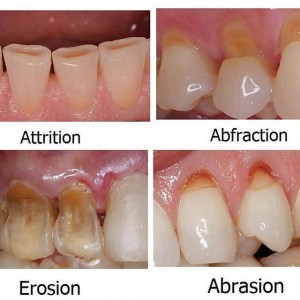DIFFERENCE BETWEEN ABFRACTION, ABRASION, EROSION AND ATTRITION
Abfraction, abrasion, erosion and attrition all involve some tooth damage, but at different locations on the tooth. While they have varying causes, they can interact and create a bigger problem. It’s possible to have abfraction, abrasion, erosion and attrition at the same time.
Abfraction
Abfraction is a wedge-shaped flaw on the tooth at the point it meets the gumline.
It’s caused by friction and pressure on the tooth and gums, which causes the neck of the tooth to start breaking off.
Abrasion
Abrasion is likely to be found on the teeth closest to your cheeks, also known as the buccal side. Unlike the V-shaped appearance of abfraction, the damage caused by abrasion is flat.
Abrasion is caused by friction from foreign objects, such as pencils, fingernails, or mouth piercings. Using a hard toothbrush, abrasive tooth products, and improper brushing technique can also lead to abrasion.
Erosion
Erosion is the general wearing away of tooth enamel. Teeth may have a more rounded appearance, with hint of transparency or discoloration. As erosion progresses, you can start to see dents and chips in the teeth.
Unlike abfraction and abrasion, erosion is more of a chemical process, happening on the surface and subsurface of the teeth. It’s caused by high acid levels in the saliva. This may be due to acidic foods or drinks, dry mouth, or health conditions that cause frequent vomiting.
Attrition
Dental attrition is a type of tooth wear caused by tooth-to-tooth contact, resulting in loss of tooth tissue, usually starting at the incisal or occlusal surfaces. Tooth wear is a physiological process and is commonly seen as a normal part of aging.




